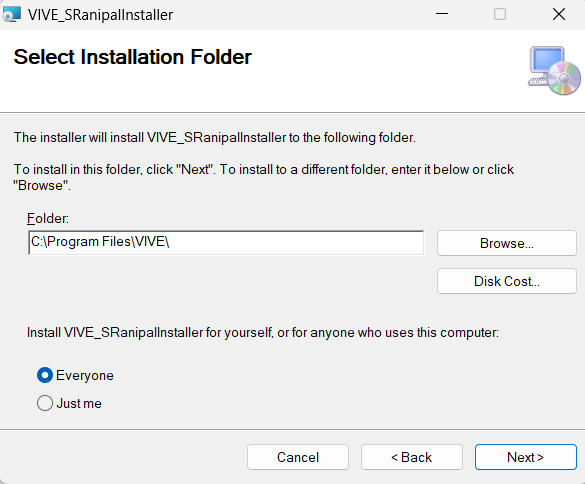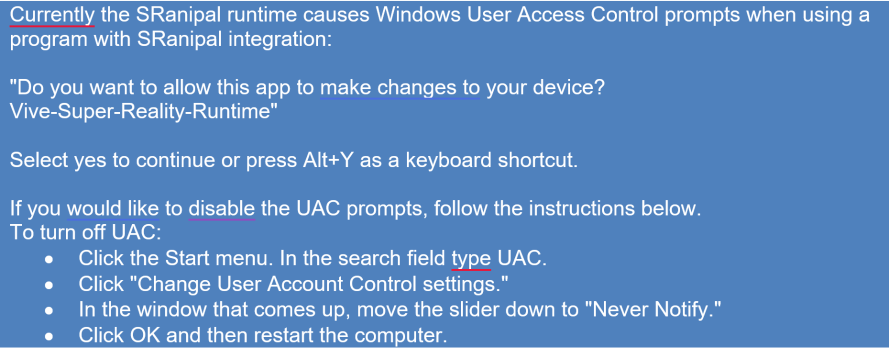Almalence Digital Lens OpenXR Layer Setup for Vive Pro Eye
Introduction
This instruction describes setting up Almalence Digital Lens OpenXR Layer on Vive Pro Eye VR head-mounted display.
| Hardware requirements | - Vive Pro Eye. - NVIDIA GeForce GTX 1080 or later. |
| Software requirements | - Windows 10 (64-bit) or later. - SteamVR 1.26.6 or later. - SRanipal Runtime 1.3.2.0 |
SRanipal Runtime setup:
- DLVR OpenXR Layer only supports SRanipal Runtime v1.3.2.0. If you have any version of SRanipal Runtime other than v1.3.2.0 installed, uninstall it before installing the correct version.
Download Sranipal Runtime v1.3.2.0 from: https://hub.vive.com/en-US/download/VIVE_SRanipalInstaller_1.3.2.0.msi
During the installtion process, at the "Select Installation Folder" step, select install for everyone at the bottom of the window:

- Close SteamVR if it's open. Run the installed SRanipal Runtime (You can find it in the Windows Programs list) to complete the installation of SRanipal runtime. If all is completed successfully - you will see its icon in the system tray:

? If you have any problem during installation, check this HTC forum topic or the official instructions.
SteamVR OpenXR runtime setup:
- Run SteamVR and put on your headset. Open SteamVR's menu if it isn't already opened, and from the System Dashboard in VR, select the VIVE Pro Eye icon (as in the image below). Enable Eye Tracking and complete the eye tracking calibration process. (For Almalence DLVR to work correctly and provide the best experience, you need to calibrate the eye-tracking software on your device).

- Take off your HMD. In the SteamVR window, click the menu button and go to Settings.
- Go to the Video settings tab and switch the "Render Resolution" option to "Custom." Set the "Resolution Per Eye" option to 100%. For a better experience, the "Resolution Per Eye" parameter should equal 2016 x 2240 or near that value.
- Open the "OpenXR" tab and make sure that "Current OpenXR Runtime" is set to "SteamVR." If it is not, click the "Set SteamVR as OpenXR Runtime" button.
In older versions of SteamVR, at the bottom of the window, switch "Advanced Settings" to "Show," and you can find the "Set SteamVR as OpenXR Runtime" button in the "Developer" section.
Launch your app
Almalence OpenXR Layer will be automatically enabled if:
- Your app supports OpenXR runtime.
- Your app uses the following graphics API: DirectX11/12, Vulkan.
- You have made the settings described above.
In case installation and configuration were successful, you will see the following message when launching any OpenXR-compatible app:

Almelence OpenXR layer requires SRanipal Runtime to run. When launching an application that supports Almalence OpenXR Layer, if the runtime has not been started before, you will see a request from Windows User Access Control to allow the SRanipal Runtime to run. You need to accept it.
From SRanipal FAQ:

The best way to see the effect of the Digital Lens plugin is to toggle it on/off by using [DELETE] button on your PC keyboard.
The effect of Almalence DLVR is best observed at high-resolution textures and scenes with lots of fine details.
Any OpenXR-compatible application shall work with Almalence OpenXR Layer. Just in case, below are a few applications that have been tested with Almalence OpenXR Layer:
- Microsoft Flight Simulator
- Beat Saber v1.29.4 and later
- Treekeepers
- FlashOut
- Blender (VR plugin)
Questions, troubleshooting, and support:
If you have any questions, you can contact support: dlplugin@almalence.com
Uninstalling or disabling Almalence OpenXR Layer
In SteamVR 1.26.6 and later versions, you can disable Almalence OpenXR Layer in the OpenXR tab in the SteamVR settings. With previous versions of SteamVR, you will have to uninstall the layer using Windows Add/Remove Programs function.
